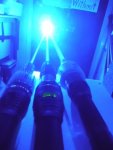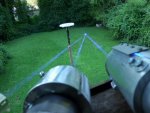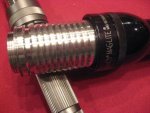- Joined
- Jul 10, 2015
- Messages
- 9,907
- Points
- 113
It will vary greatly depending on ambient temp, I see a big difference in my static heat sinks between summer and winter when used outside........the best way to negate this is forced air, if you look at the projectors they use fan over fins and later models use heat piping and radiators but that's also a matter of remote locating and package but just a static heat sink would need to be quite large to dissipate 15w continuously, that's why so many things use fans......now if the max operating temp had enough differential, if the diode could run at 350F then it could get by with a smaller static sink, but as in summer time the differential is so small and you want continuous 100% duty cycle you need a fan, or compromise on your cool down........something I used to do is let one unit cool while lasing with another.
Also if you build several you can fire them all up at once
p.s. There's a beam stop attached to the door in my pic.


Also if you build several you can fire them all up at once
p.s. There's a beam stop attached to the door in my pic.


Last edited:









